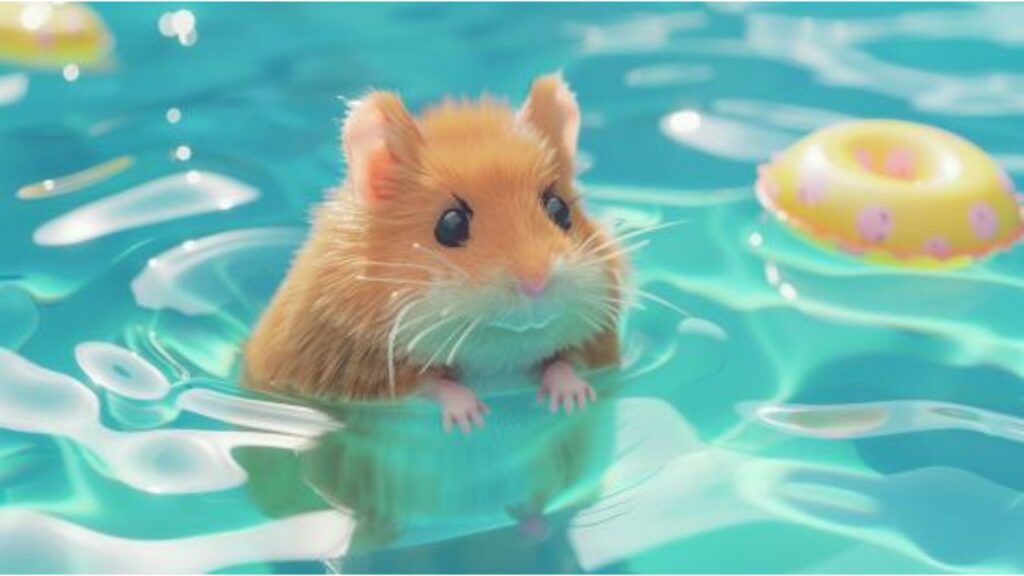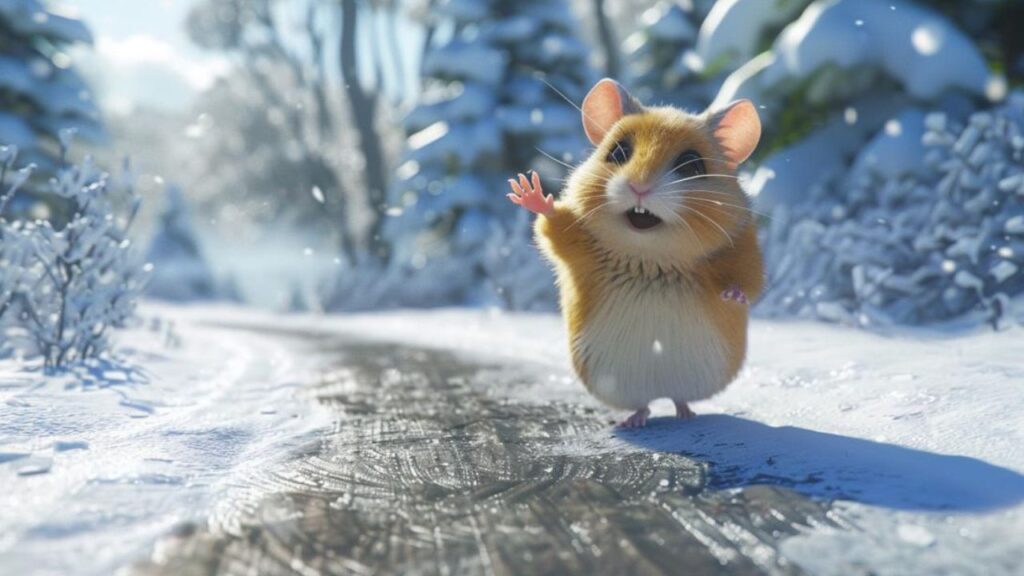As the leaves change color and the air shifts from the warm breezes of summer to the crisp whispers of autumn, it’s not just our wardrobes that require a transition—our furry friends do too. Especially for the tiny, yet immensely significant members of our families: our hamsters. Adjusting your hamster’s routine with the seasons is crucial, not merely for their comfort but for their health and happiness as well. This seasonal shift in care is essential, as each season presents its unique set of challenges and opportunities for your little companion.
In this comprehensive guide, you’ll learn the ins and outs of fine-tuning your hamster’s care routine to align with the changing seasons. From dietary adjustments to habitat modifications, we’ll cover all you need to know to ensure your hamster remains not just surviving, but thriving, no matter what the weather outside may be.
Seasonal Sensitivity: Understanding Your Hamster’s Needs
Hamsters, despite their small size, are highly sensitive to environmental changes. As the seasons transition, so do their needs. In the warmer months, your hamster might require more water and cooler living conditions to prevent overheating. Conversely, winter calls for warmer bedding and possibly a slight dietary change to keep them well-nourished and comfortable. Recognizing and responding to these needs is paramount in providing a nurturing environment for your pet.
Tailored Care: Adapting to Each Season
- Spring into Action: Refreshing Your Hamster’s Habitat. Spring is a time of renewal and rejuvenation, not just for us but for our hamster pals as well. It’s the perfect opportunity to deep clean their cage, introduce new toys, and maybe even rearrange their living space to give them a fresh new perspective on life.
- Summer and Winter Wellness: Temperature and Diet Adjustments. The extreme seasons require special attention. During the hot summer months, ensuring your hamster has ample shade and ventilation becomes key. In contrast, winter might mean upping the cozy factor with extra bedding and adjusting their diet to meet their higher energy needs.
By the end of this guide, you’ll be equipped with the knowledge to adjust your hamster’s routine seamlessly with the seasons, ensuring they’re always at their happiest and healthiest. And remember, while the specifics of care might change with the weather, the underlying requirement remains the same: a whole lot of love and attention.
Understanding Your Hamster’s Natural Cycles

When we think of our cuddly hamster friends, it’s easy to forget that they, like us, are affected by the changing seasons. Their behaviors, sleep patterns, and even dietary needs can shift throughout the year. By tuning into these natural cycles, we can provide care that not only meets but anticipates their needs, ensuring they remain happy, healthy, and active, no matter the season.
Seasonal Changes and Hamster Behavior
The length of daylight and fluctuations in temperature play significant roles in influencing your hamster’s mood and activity levels. As the days grow shorter and the nights longer, you may notice your hamster becoming more nocturnal, active during the late hours of the night and into the early morning. This shift is a natural response to the decreased daylight hours of autumn and winter. Conversely, during the longer days of spring and summer, your hamster might be more inclined to wake earlier in the evening and be active for longer periods.
Temperature also impacts your hamster’s behavior. In the wild, hamsters prepare for winter by collecting food and creating cozy burrows. While domestic hamsters don’t need to stockpile food, they still feel the instinct to nest and may become more sedentary as the temperature drops. Recognizing these behaviors as natural responses to the changing environment can help you adjust your care routine to keep them comfortable and engaged.
The Science of Sleep: Winter vs. Summer
Hamsters are known for their unique sleep patterns, often waking and sleeping in short intervals throughout the day and night. These patterns can shift with the seasons. In winter, you might find your hamster sleeping more as the reduced daylight affects their circadian rhythms. This doesn’t mean they’re unwell; rather, they’re adapting to the seasonal change in a healthy, natural way.
In contrast, during the summer months, the extended daylight can lead to more fragmented sleep patterns. You might notice your hamster taking shorter, more frequent naps or being more active at dusk. It’s important to mimic natural light cycles as much as possible in their habitat to support their internal clock, perhaps by adjusting the lighting in the room where your hamster lives to more closely follow the natural rise and set of the sun.
Dietary Adjustments for Optimal Health
As the seasons change, so too should your hamster’s diet. This doesn’t mean a complete overhaul with each changing leaf or snowflake, but rather a thoughtful adjustment to align with their shifting energy needs and the availability of seasonal foods.
In the colder months, your hamster may appreciate a slight increase in high-energy foods to help maintain their body temperature and energy levels. Incorporating small amounts of nuts or seeds can be a welcome addition to their diet. However, it’s crucial to balance these richer foods with their regular diet to avoid obesity.
Spring and summer offer the opportunity to introduce fresh foods into their diet. Small portions of vegetables or fruits can provide necessary vitamins and ensure your hamster stays hydrated, especially in warmer weather. Always introduce new foods gradually and in moderation to prevent digestive upset.
Adjusting your hamster’s care with the seasons isn’t just about responding to their needs; it’s about anticipating them. By understanding the natural cycles that influence your hamster’s behavior, sleep, and dietary needs, you can create a nurturing environment that adapts fluidly to the rhythm of the seasons. This proactive approach to care ensures your hamster not only survives but thrives, no matter what the weather outside may bring.
Creating a Seasonally Adaptive Environment

Ensuring your hamster’s habitat is responsive to the changing seasons is key to their overall well-being. Just as we adapt our homes to be warmer in winter and cooler in summer, so too should we adjust our hamster’s environment. From managing temperature to mimicking natural daylight cycles and introducing seasonal enrichment activities, these adaptations can significantly enhance your hamster’s quality of life.
Temperature Control: Keeping Cozy in Winter, Cool in Summer
Maintaining an ideal temperature in your hamster’s habitat is crucial for their health. Hamsters thrive in temperatures between 65°F and 75°F (18°C to 24°C). Here are some tips to keep them comfortable:
- Winter Warmth: In colder months, ensure your hamster’s cage is away from drafty windows or doors. Consider using a safe, small animal heating pad under part of their cage or extra bedding to burrow into, keeping them cozy without direct heat sources that could cause harm.
- Summer Cooling: During hotter periods, keep your hamster’s habitat out of direct sunlight and use ceramic tiles or a shallow, cool water bath for them to lie against or in to cool down. Ensure their space is well-ventilated; a small, safe fan in the room can help circulate air without blowing directly on the cage.
Lighting the Way: Mimicking Natural Daylight Cycles
Hamsters, particularly nocturnal species, benefit from a natural light-dark cycle to regulate their circadian rhythms. Here’s how you can mimic these cycles:
- Natural Light: Whenever possible, position your hamster’s habitat in a room with natural light that follows a normal day-night cycle, avoiding direct sunlight which can overheat their space.
- Artificial Lighting: If natural light isn’t sufficient, consider using a timer for artificial lights to mimic the sunrise and sunset, providing your hamster with a consistent cycle of 12-14 hours of light and 10-12 hours of dark. This helps regulate their sleep patterns and keeps their activity levels consistent.
Seasonal Enrichment Activities
Keeping your hamster engaged and stimulated throughout the year is important for their mental and physical health. Seasonal enrichment activities can provide variety and excitement to their routine:
- Spring and Summer: Take advantage of the warmer weather to introduce new toys and exploration opportunities. Consider a secure playpen for supervised outdoor time, allowing them to experience fresh air and natural textures under your watchful eye.
- Fall and Winter: As the weather cools, focus on indoor enrichment. DIY mazes, tunnels, and hideouts can be made from safe, chewable materials like cardboard. Rotating toys and introducing new challenges will keep your hamster interested and active, even when it’s too cold to venture outside.
By carefully adjusting your hamster’s environment to cater to the seasonal changes, you’re not just providing them with a habitat; you’re giving them a haven. From the warmth of their bedding to the cycle of light and dark, and the stimulating activities that change with the seasons, each detail contributes to their well-being, ensuring they remain healthy, happy, and engaged throughout the year.
Adjusting Your Hamster’s Exercise Routine

Physical activity is crucial for your hamster’s health, no matter the season. However, as the seasons change, so should the way you approach keeping your furry friend active. During the winter, when it’s too cold for outdoor adventures, and in the summer, when the warmth offers a perfect opportunity for safe outdoor play, adjusting your approach ensures your hamster stays healthy and engaged year-round. Plus, regular check-ups play a pivotal role in maintaining their well-being through these seasonal shifts.
Winter Workouts: Indoor Exercise Ideas
When the temperature drops, keeping your hamster active indoors becomes essential. Here are some ways to ensure your hamster gets enough exercise during the colder months:
- Exercise Wheel: Ensure your hamster has access to a solid, appropriately-sized exercise wheel. Wheels provide excellent physical activity, allowing them to run as much as they like, even when it’s too cold outside.
- Playpen Time: Set up a hamster-safe playpen with various toys and obstacles. Include tunnels, ramps, and hideouts to encourage exploration and movement.
- DIY Mazes: Create mazes or obstacle courses using cardboard boxes, tubes, and safe household items. These mazes can stimulate their problem-solving skills and encourage physical activity.
- Interactive Play: Engage with your hamster through supervised playtime outside of their cage. You can gently roll a soft ball towards them or offer a treat at the end of a small obstacle course to encourage movement.
Summer Adventures: Safe Outdoor Play
Warm, sunny days are perfect for bringing your hamster outside for a bit of exploration and fresh air, with appropriate precautions:
- Secure Outdoor Enclosure: Use a secure, escape-proof outdoor playpen to give your hamster a safe environment to explore. Ensure it’s placed in a shaded area to prevent overheating and protect them from predators.
- Supervised Playtime: Never leave your hamster unattended outside. Outdoor play should always be under your watchful eye to ensure their safety.
- Hydration: Keep fresh water available at all times, especially outdoors in the summer heat, to prevent dehydration.
- Temperature Monitoring: Be mindful of outdoor temperatures. Hamsters can overheat quickly; it’s best to avoid outdoor play during peak heat hours or when it’s excessively humid.
The Importance of Regular Check-ups
Seasonal changes can affect your hamster’s health in various ways, making regular veterinary check-ups a crucial part of their care regimen:
- Preventive Care: Regular check-ups can help catch and address potential health issues early, before they become serious. This is especially important as some health issues may be more prevalent in certain seasons, such as respiratory problems in the winter.
- Diet and Exercise Adjustments: A vet can provide personalized advice on adjusting your hamster’s diet and exercise routine to suit their specific health needs and the changing seasons.
- Wellness Monitoring: Regular visits allow your vet to monitor your hamster’s overall wellness, including weight, dental health, and coat condition, ensuring they remain healthy throughout the year.
Adapting your hamster’s exercise routine to the seasons not only keeps them physically fit but also mentally stimulated and happy. With the right indoor activities, safe outdoor play, and regular health checks, you can ensure your hamster enjoys a vibrant and healthy life all year round.
Hannah’s Training Tactics

Adjusting your hamster’s routine with the seasons doesn’t have to be a daunting task. With a few simple, actionable tips, you can ensure your furry friend stays happy, healthy, and engaged throughout the year. Here’s your quick-start guide to seasonal care, including a fun DIY project for a seasonal hamster play area that will add excitement and variety to your hamster’s life.
Quick Seasonal Care Tips
- Spring Refresh: Start the season by thoroughly cleaning your hamster’s habitat, swapping out old bedding and toys for new ones. Introduce fresh, hamster-safe greens gradually into their diet to mimic the new growth of spring.
- Summer Shade: Ensure your hamster’s cage is never in direct sunlight. Use a ceramic tile in their play area for them to cool off on. Offer fresh water consistently, and consider freezing small pieces of fruit for a refreshing treat.
- Autumn Adventures: As the weather cools, it’s a great time for your hamster to explore. Create a secure indoor play area with autumn-themed decorations like non-toxic leaves and pet-safe wooden toys for them to gnaw on.
- Winter Warmth: Increase the depth of your hamster’s bedding in the winter months to help them stay warm. Consider a warm, safe spot in their cage where they can retreat and feel secure, like a small, cozy hamster house filled with extra bedding for burrowing.
DIY Seasonal Hamster Play Area
Creating a seasonal play area for your hamster is a fantastic way to provide enrichment and encourage physical activity. Here’s a simple DIY project that you can customize for any season:
Materials Needed:
- A large, shallow cardboard box or plastic bin
- Non-toxic paint and brushes (optional for decoration)
- Safe, hamster-friendly materials like paper tubes, small boxes, untreated wood blocks, and fabric scraps
- Seasonal decorations (ensure these are safe and non-toxic if your hamster decides to nibble on them)
Instructions:
- Prepare the Base: If you’re using a cardboard box, reinforce the sides with additional cardboard or duct tape to prevent escapes. For a plastic bin, ensure there are air holes on the sides for ventilation.
- Decorate: Paint the outside of the box or bin with non-toxic paint to match the season. Think greens and flowers for spring, bright sunny colors for summer, warm oranges and browns for autumn, and cool blues and whites for winter.
- Add Features: Inside the play area, create little zones using the materials. You could build a small obstacle course with paper tubes and boxes, a digging zone with shredded paper, and a cozy corner with fabric scraps.
- Seasonal Touch: Add seasonal decorations to enhance the theme. This could be anything from fake flowers in spring, a small sandbox in summer, colorful leaves in autumn, or cotton bedding for snow in winter. Always supervise your hamster to ensure they don’t ingest anything harmful.
This play area provides a unique and stimulating environment for your hamster to explore. It’s a great way to enrich their daily routine and can be easily changed or updated to reflect the current season.
Conclusion

Throughout our journey today, we’ve explored the multifaceted approach to adjusting your hamster’s routine with the seasons, ensuring their happiness and health all year round. We’ve delved into understanding your hamster’s natural cycles, including how seasonal changes can affect their behavior, sleep patterns, and dietary needs. We’ve also covered the importance of creating a seasonally adaptive environment, from temperature control to mimicking natural daylight cycles and introducing seasonal enrichment activities.
Moreover, we’ve discussed how to keep your hamster physically active and mentally stimulated through indoor exercises during the colder months and safe outdoor play when the weather permits. The significance of regular vet check-ups to catch any potential health issues early cannot be overstated, as it ensures your hamster remains in top condition throughout the seasonal shifts.
In “Hannah’s Training Tactics,” we provided quick, actionable tips and introduced a DIY project for creating a seasonal hamster play area, offering a fun and engaging way to enrich your hamster’s environment and routine.
As we wrap up, I encourage you to embrace the seasonal changes and see them as opportunities to enhance the care you provide to your furry friend. Each season brings its own charm and set of challenges, but with the right knowledge and preparation, you can ensure your hamster navigates these changes with ease. Remember, the effort you put into adapting your hamster’s routine with the seasons not only contributes to their physical well-being but also deepens the bond you share with them.
Adjusting your hamster’s care with the seasons is a rewarding journey that requires observation, adaptation, and a lot of love. So, as you go forward, remember that with paws and patience, you’re on the road to being a Hamster Whisperer.
Happy training!
“With paws and patience, you’re on the road to being a Hamster Whisperer. Happy training!”




